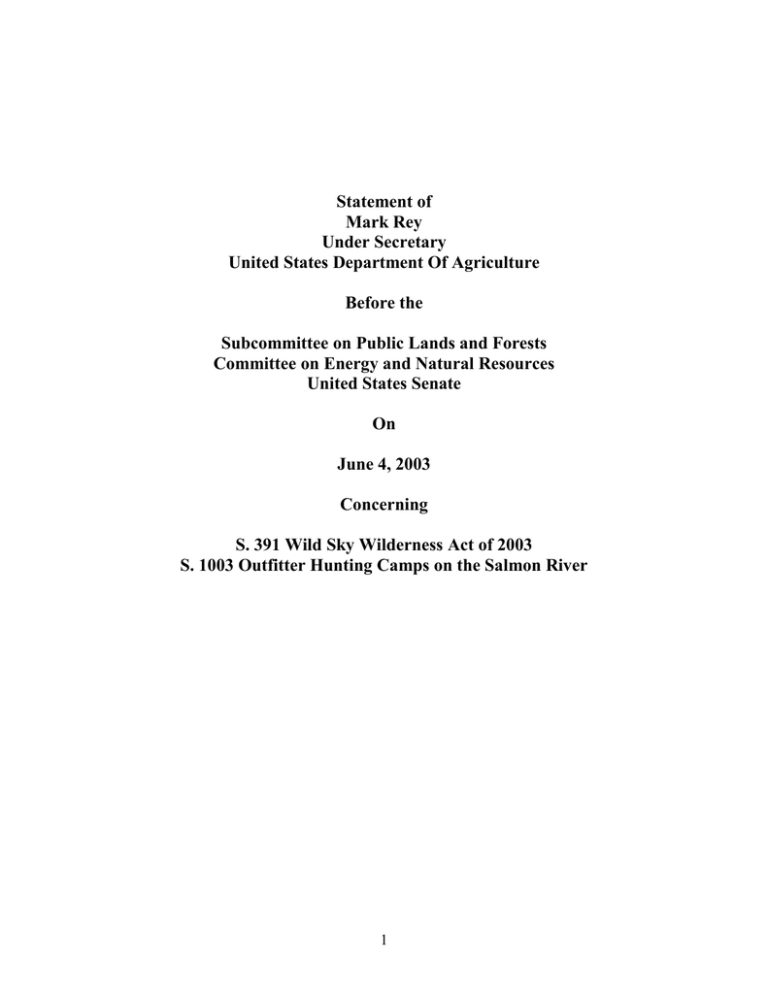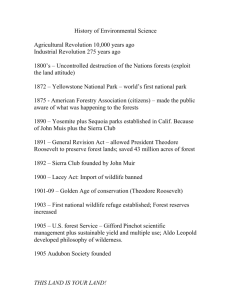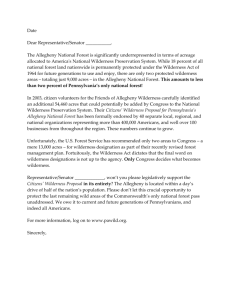Statement of Mark Rey Under Secretary
advertisement

Statement of Mark Rey Under Secretary United States Department Of Agriculture Before the Subcommittee on Public Lands and Forests Committee on Energy and Natural Resources United States Senate On June 4, 2003 Concerning S. 391 Wild Sky Wilderness Act of 2003 S. 1003 Outfitter Hunting Camps on the Salmon River 1 Mr. Chairman and members of the subcommittee, thank you for the opportunity to appear before you today. I am Mark Rey, Natural Resources and Environment Under Secretary for the United States Department of Agriculture. I am here today to provide the Administration’s comments on S. 391—Wild Sky Wilderness Act of 2003 and S. 1003—Outfitter Hunting Camps on the Salmon River. S. 391—The Wild Sky Wilderness Act of 2003 S. 391 would create approximately 106,000 acres of additional wilderness on the Mt. BakerSnoqualmie National Forest in the State of Washington. It directs the Secretary to assure adequate access to private in-holdings within the Wild Sky Wilderness and establish a trail plan for hiking and equestrian trails within and adjacent to the wilderness. The bill authorizes the use of helicopter access to construct and maintain a joint Forest Service and Snohomish County repeater site to provide improved communication for safety, health, and emergency services. S. 391 also requires the Secretary to exchange specified lands with the Chelan County Public Utility District if the District offers to the Secretary approximately 371.8 acres within the Mt. Baker-Snoqualmie National Forest, in exchange for a permanent easement, including helicopter access, consistent with such levels as used as of the date of this bill's enactment, to maintain an existing snotel site on 1.82 acres on the Wenatchee National Forest. The snotel site is currently used to monitor the snow pack for calculating expected runoff into hydroelectric projects. If, after the exchange occurs, Chelan County notifies the Secretary that they no longer need to maintain the snotel site, the easement will be extinguished and all rights conveyed by this exchange would revert to the United States. 2 The Department does not oppose the designation of the Wild Sky Wilderness as a component of the National Wilderness Preservation System. We recognize and commend the delegation for its collaborative approach and local involvement that contribute to bipartisan support for this bill. However, the Department would like to work with the Committee to improve S. 391. While the vast majority of the lands described in S. 391 are appropriate for wilderness designation, the Department has significant concerns with approximately 16,000 acres. These acres would not be considered suitable for wilderness designation under the provisions of the 1964 Wilderness Act or under existing Forest Service regulations and planning direction. The Department believes that the current allocation of these lands under the Mt. Baker-Snoqualmie Forest Plan continues to be the most suitable designation for these acres. The lands that we believe are appropriate for designation under the Wilderness Act, approximately 90,000 acres, consist of all of the Eagle Rock Roadless Area and portions of Glacier Peak A, B, K, and L. These areas retain their undeveloped character and are largely without permanent improvements or human habitation. Limiting the wilderness designation to these lands would address many of the Department’s concerns. The areas we propose for exclusion from wilderness designation include low elevation forests that have been utilized for timber harvest and mining over the last 80 years, still showing visible evidence of road building, logging and mining activities. 3 The areas also include approximately 27 miles of existing roads, some of which are all weather, drivable, and graveled. Several of the roads receive significant visitor use associated with recreation opportunities. The Rapid River Road is such a travel way and we recommend excluding it, in its entirety, from wilderness designation. The types of recreation experiences enjoyed by users along the Rapid River Road corridor include driving for pleasure, nature photography, fishing, picnicking and dispersed camping at a number of pull-off sites along the road. In the winter snowmobiles use this road as a part of the snowmobile trail system, traveling to its end point. Another concern lies with roads, both outside and adjacent to the proposed wilderness boundary that have narrow corridors subject to landslide and river bank erosion. This situation poses significant public access and resource management issues, as the proximity of the proposed boundary could result in constraints related to necessary repairs and road reconstruction work. We would like to work with the Committee on more appropriate boundaries. Further, we propose the exclusion of most of the approximately 2,400 acres of private patented mining claims and private timberlands. A boundary adjustment in the Silver Creek drainage would remove most of the private lands from the proposed Wilderness. Finally, the approach to naming these disconnected areas of land collectively as the Wild Sky Wilderness may cause public confusion, particularly since some of the areas proposed for designation are immediately adjacent to the existing Henry M. Jackson Wilderness. In order to minimize administrative costs and reduce public confusion, the Department suggests designating 4 only Eagle Rock Roadless Area as Wild Sky Wilderness. The Glacier Peak Roadless Areas A,B,K, and L should become additions to the adjacent Henry M. Jackson Wilderness in further tribute to the Senator. The Department supports the administrative provisions in the bill, particularly provisions for a repeater site to provide improved communications for safety and health purposes. The Department also supports the provisions for land exchange in the Glacier Peak Wilderness and provisions for management of the existing snotel site in that wilderness. S. 1003—Outfitter Hunting Camps on the Salmon River S. 1003 would amend the Wild and Scenic Rivers Act to clarify the intent of Congress with respect to the continued use of three long-established commercial outfitter hunting camps on the Salmon River. S. 1003 would direct the continued authorization of the use and occupancy of lands and maintenance or replacement facilities and structures for commercial recreation services at Stub Creek, Artic Creek, and Smith Gulch. The Forest Service’s special use permits for the camps would be subject to revocation only for noncompliance. If revoked, S. 1003 would require the Forest Service to re-offer the permits through a competitive process. The hunting camps in question are located on the wild section of the Salmon Wild and Scenic River in the Frank Church-River of No Return Wilderness managed by the Salmon and Challis National Forests. The camps were in existence prior to the passage of the Central Idaho 5 Wilderness Act of 1980, which designated the river segment as a component of the Wild and Scenic River system. One of the camps was relocated to Smith Gulch in 1988. The camps operate under special use permits administered by the Forest Service and they provide unique, traditional services and experiences to the public in a setting that cannot be duplicated. Historically, the Forest Service had taken the position that the camps – and the associated permanent facilities that are at issue – are consistent with agency policy and the law. In 1995 the Forest Service reauthorized the special use permits for the camps through 2010. In 2000, however, a federal court found the permanent facilities to be in violation of the Wild and Scenic Rivers Act and ordered the Forest Service to have them removed. When the court ordered the Forest Service to remove these facilities, it also directed the agency to consider the needs of the camp owners in setting a timetable for removal. In January 2003, the Supervisor of the Salmon-Challis National Forest signed a Record of Decision (ROD) that continued use of the camps with temporary facilities and set a schedule for removal of all permanent facilities at the three camps by December 31, 2005. Mr. Chairman, the Administration supports Senator Craig’s efforts to clarify that Congress intended for permanent hunting camps be located within the river corridor. This clarification regarding the three camps specifically identified in S. 1003 would resolve a long-standing issue related to the administration of the corridor by local Forest Service officials. 6 The Administration would like to work with the Committee on amendments to S. 1003 that would provide the Secretary maximum flexibility to make appropriate determinations as to the future terms and conditions under which the use and occupancy of national forest system lands are authorized so that these three camps will provide high quality, traditional, services that meets the public’s needs, adheres to the legal requirements related to special use authorizations on national forest system lands, and is consistent with the public expectations for river corridors listed under the Wild and Scenic Rivers Act. This concludes my statement. I would be happy to answer your questions. 7






